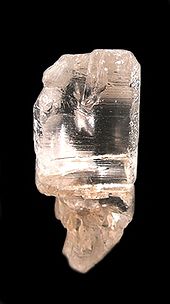| Revision as of 23:34, 26 November 2017 edit95.192.20.73 (talk) Low iron source of Li eg for making glass (added as flux to lower the melting point)← Previous edit | Revision as of 05:20, 29 November 2017 edit undoGustavo.bng (talk | contribs)97 editsm +"and statesman"Tag: Visual editNext edit → | ||
| Line 43: | Line 43: | ||
| ==Discovery and occurrence== | ==Discovery and occurrence== | ||
| ] | ] | ||
| Discovered in 1800, by Brazilian naturalist ]. Type locality: ], ], ]. The name is derived from the Greek word petalon, which means ''leaf'' (perfect cleavage).<ref name=Mindat/><ref>{{cite journal | url = http://www.biodiversitylibrary.org/item/29658#page/256/mode/1up | page= 239 | title = Des caractères et des propriétés de plusieurs nouveaux minérauxde Suède et de Norwège , avec quelques observations chimiques faites sur ces substances | Discovered in 1800, by Brazilian naturalist and statesman ]. Type locality: ], ], ]. The name is derived from the Greek word petalon, which means ''leaf'' (perfect cleavage).<ref name=Mindat/><ref>{{cite journal | url = http://www.biodiversitylibrary.org/item/29658#page/256/mode/1up | page= 239 | title = Des caractères et des propriétés de plusieurs nouveaux minérauxde Suède et de Norwège , avec quelques observations chimiques faites sur ces substances | ||
| | last = D'Andraba | authorlink=José Bonifácio de Andrada| journal = Journal de chimie et de physique | volume = 51| date = 1800 }}</ref><ref>{{cite book |author1=Sowerby |url=https://books.google.com/books?id=2RtaAAAAYAAJ&pg=RA2-PT137 |title=Exotic mineralogy: Or, Coloured figures of foreign minerals: As a supplement to British mineralogy |first1=James |year=1811}}</ref> | | last = D'Andraba | authorlink=José Bonifácio de Andrada| journal = Journal de chimie et de physique | volume = 51| date = 1800 }}</ref><ref>{{cite book |author1=Sowerby |url=https://books.google.com/books?id=2RtaAAAAYAAJ&pg=RA2-PT137 |title=Exotic mineralogy: Or, Coloured figures of foreign minerals: As a supplement to British mineralogy |first1=James |year=1811}}</ref> | ||
Revision as of 05:20, 29 November 2017
| Petalite | |
|---|---|
 Petalite from Minas Gerais State, Brazil (size: 3x4 cm) Petalite from Minas Gerais State, Brazil (size: 3x4 cm) | |
| General | |
| Category | Tectosilicate |
| Formula (repeating unit) | LiAlSi4O10 |
| Strunz classification | 9.EF.05 |
| Crystal system | Monoclinic |
| Crystal class | Prismatic (2/m) (same H-M symbol) |
| Space group | P2/a |
| Unit cell | a = 11.737 Å, b = 5.171 Å, c = 7.63 Å; β = 112.54°; Z = 2 |
| Identification | |
| Color | Colorless, grey, yellow, pink, to white |
| Crystal habit | Tabular prismatic crystals and columnar masses |
| Twinning | Common on {001}, lamellar |
| Cleavage | Perfect on {001}, poor on {201} with 38.5° angle between the two |
| Fracture | Subconchoidal |
| Tenacity | Brittle |
| Mohs scale hardness | 6 - 6.5 |
| Luster | Vitreous, pearly on cleavages |
| Streak | Colorless |
| Diaphaneity | Transparent to translucent |
| Specific gravity | 2.4 |
| Optical properties | Biaxial (+) |
| Refractive index | nα=1.504, nβ=1.510, nγ=1.516 |
| Birefringence | δ = 0.012 |
| 2V angle | 82 – 84° measured |
| Melting point | 1350 °C |
| Fusibility | 5 |
| Solubility | Insoluble |
| References | |
Petalite, also known as castorite, is a lithium aluminium tectosilicate mineral LiAlSi4O10, crystallizing in the monoclinic system. Petalite is a member of the feldspathoid group. It occurs as colorless, grey, yellow, yellow grey, to white tabular crystals and columnar masses. Occurs in lithium-bearing pegmatites with spodumene, lepidolite, and tourmaline. Petalite is an important ore of lithium, and is converted to spodumene and quartz by heating to ~500 °C and under 3 kbar of pressure in the presence of a dense hydrous alkali borosilicate fluid with a minor carbonate component. Petalite (and secondary spodumen formed from it) is lower in iron than primary spodumen making it a more useful source of lithium in e.g. the production of glass. The colorless varieties are often used as gemstones.
Discovery and occurrence

Discovered in 1800, by Brazilian naturalist and statesman Jose Bonifacio de Andrada e Silva. Type locality: Utö Island, Haninge, Stockholm, Sweden. The name is derived from the Greek word petalon, which means leaf (perfect cleavage).
Economic deposits of petalite are found near Kalgoorlie, Western Australia; Aracuai, Minas Gerais, Brazil; Karibib, Namibia; Manitoba, Canada; and Bikita, Zimbabwe.
The first important economic application for petalite was as a raw material for the glass-ceramic cooking ware CorningWare. It has been used as a raw material for ceramic glazes.
References
- "Petalite". Digital Fire. Retrieved 23 October 2011.
- Handbook of Mineralogy
- Webmineral
- ^ Mindat
- *Hurlbut, Cornelius S. and Klein, Cornelis, 1985, Manual of Mineralogy, Wiley, 20th ed., pp. 459-460 ISBN 0-471-80580-7
- Deer, W. A. (2004). Framework silicates: silica minerals, feldspathoids and the zeolites (2. ed.). London: Geological Soc. p. 296. ISBN 1-86239-144-0.
- D'Andraba (1800). "Des caractères et des propriétés de plusieurs nouveaux minérauxde Suède et de Norwège , avec quelques observations chimiques faites sur ces substances". Journal de chimie et de physique. 51: 239.
- Sowerby, James (1811). Exotic mineralogy: Or, Coloured figures of foreign minerals: As a supplement to British mineralogy.
External links
 Media related to Petalite at Wikimedia Commons
Media related to Petalite at Wikimedia Commons- "Petalite" . Encyclopædia Britannica. Vol. 21 (11th ed.). 1911.